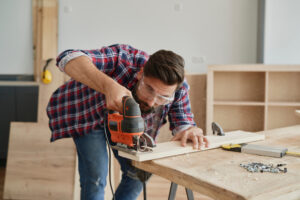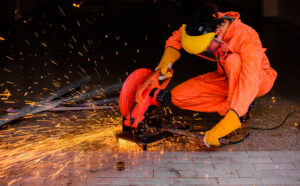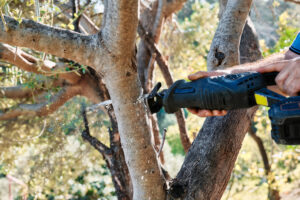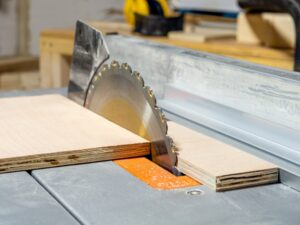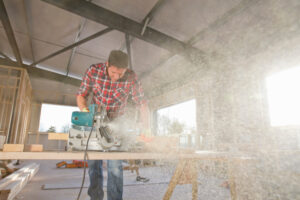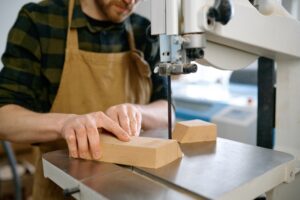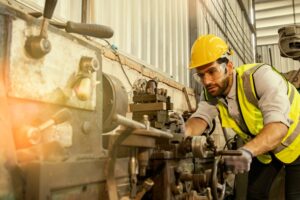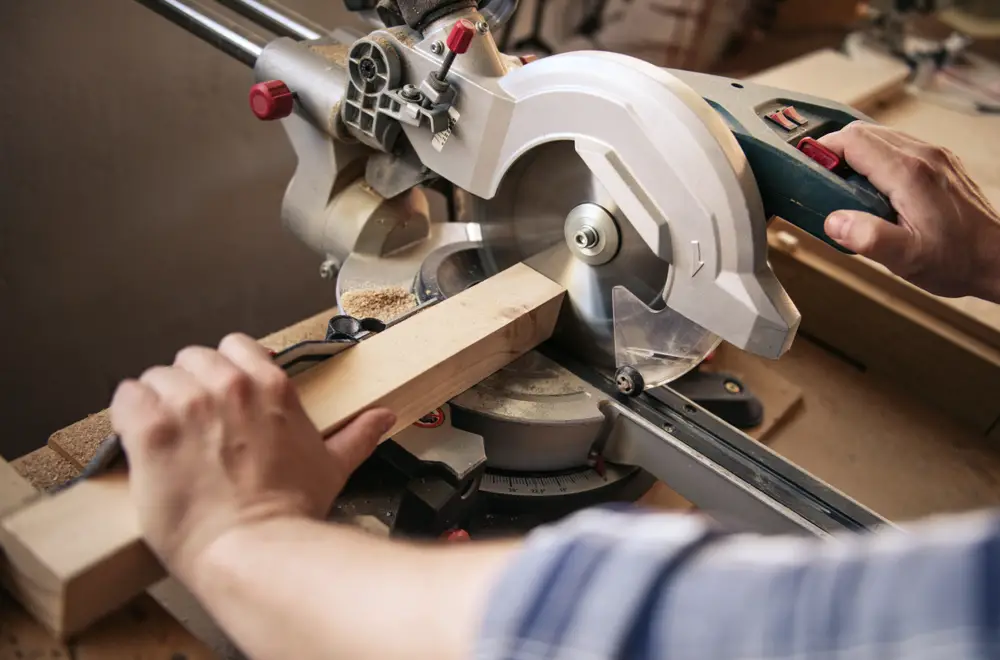
Accidents can happen when using a mitre saw, even though it is often considered a safe tool. Improperly securing the wood or using hand pressure instead of clamps can lead to serious injuries. It is important to be aware of the potential dangers and take necessary precautions to ensure the safe usage of a mitre saw.
Key Takeaways
- Properly secure the workpiece with clamps to avoid accidents.
- Always wear safety glasses to protect your eyes from debris.
- Follow the ON/OFF controls and operate the saw with caution.
- Maintain and inspect the mitre saw regularly for safety.
- Avoid using the tool near flammable materials.
Understanding the Anatomy of a Mitre Saw
A mitre saw is a versatile power tool commonly used for making accurate crosscuts and angled cuts in various materials. To fully grasp its functionality and operate it safely, it’s important to understand the anatomy of a mitre saw.
Pivoting Arm and Circular Blade
At the heart of a mitre saw is a circular blade mounted on a pivoting arm. This blade, typically made of high-speed steel or carbide-tipped material, rotates at high speed to cut through the workpiece. It is crucial to handle the blade with caution, as it can cause serious injuries if not used properly.
The Guard and Fence
A mitre saw features a guard that surrounds the blade. This guard is designed to retract during cutting operations, exposing the blade only when necessary. It is essential to ensure that the guard is in place and functioning correctly before operating the saw, as it provides a crucial layer of protection.
The fence, located at the rear of the saw table, serves as a guide for the workpiece. It prevents the material from being thrown backwards during cutting and helps maintain accuracy. Proper alignment and adjustment of the fence are essential for achieving precise cuts.
| Component | Description |
|---|---|
| Pivoting Arm | The arm that holds the circular blade and allows it to rotate for cutting. |
| Circular Blade | The cutting tool, usually made of high-speed steel or carbide-tipped material. |
| Guard | The safety feature that surrounds the blade and retracts during cutting. |
| Fence | The guide at the rear of the saw table that assists in maintaining accurate cuts. |
Common Injuries Associated with Mitre Saw Operation
When working with a mitre saw, it is important to be aware of the potential injuries. Two common types of injuries associated with mitre saw operation are eye injuries and off-hand injuries. These injuries can be severe and have long-lasting consequences if proper safety precautions are not taken.
Eye injuries are a significant risk when using a mitre saw. The high-speed rotation of the blade can cause debris or fragments to be thrown towards the operator, resulting in eye damage. It is crucial to wear appropriate safety glasses or goggles to protect your eyes from these hazards. Additionally, ensuring that the saw’s guard is in place and functioning correctly can help prevent debris from reaching your eyes.
Off-hand injuries, on the other hand, occur when the non-operating hand accidentally comes into contact with the blade. This can happen when holding the workpiece with your hand instead of using clamps or when reaching too close to the blade during operation. These injuries can be severe, resulting in deep cuts or even finger amputations. Always use clamps to secure the workpiece and keep your hands clear of the blade’s path to minimise the risk of off-hand injuries.
Table: Common Injuries Associated with Mitre Saw Operation
| Injury Type | Description |
|---|---|
| Eye Injuries | Caused by debris or fragments thrown towards the operator during blade contact or high-velocity projectiles. Can result in eye damage or injury. |
| Off-Hand Injuries | Occurs when the non-operating hand comes into contact with the blade. Can happen when holding the workpiece with your hand instead of using clamps or reaching too close to the blade during operation. Can result in deep cuts or finger amputations. |
Preventing Mitre Saw Accidents: Essential Safety Tips
When it comes to using a mitre saw, prioritising safety is crucial. By following essential safety tips, you can significantly reduce the risk of accidents and ensure a safer working environment. Here are some key precautions to keep in mind:
1. Wear Safety Glasses
Protecting your eyes should be a top priority when using a mitre saw. Always wear safety glasses to shield your eyes from flying debris and potentially harmful materials. Accidents can happen in a split second, so it’s better to be safe than sorry.
2. Clamp the Workpiece
Using your hand to hold the workpiece while operating the saw is a recipe for disaster. Instead, secure the workpiece with clamps, ensuring that it is firmly locked in place. This will provide stability and prevent any unexpected movements that could lead to accidents.
3. Keep the Guards in Place
The guards on a mitre saw are designed to protect you during operation. Make sure the guards, including the blade guard, are in the correct position and functioning properly. Never remove or disable them, as they provide crucial protection against potential hazards.
4. Wait for the Blade to Stop
After making a cut, always wait for the blade to come to a complete stop before moving or adjusting the workpiece. Trying to handle the material while the blade is still spinning can lead to accidental contact and serious injuries. Be patient and prioritise your safety.
By following these safety precautions, such as wearing safety glasses, clamping the workpiece, and ensuring the guards are in place, you can minimise the risk of mitre saw accidents. Remember, safety should never be compromised when working with power tools.
| Safety Precautions | Importance |
|---|---|
| Wear safety glasses | Protects eyes from debris |
| Clamp the workpiece | Provides stability |
| Keep guards in place | Prevents contact with blade |
| Wait for the blade to stop | Avoids accidental contact |
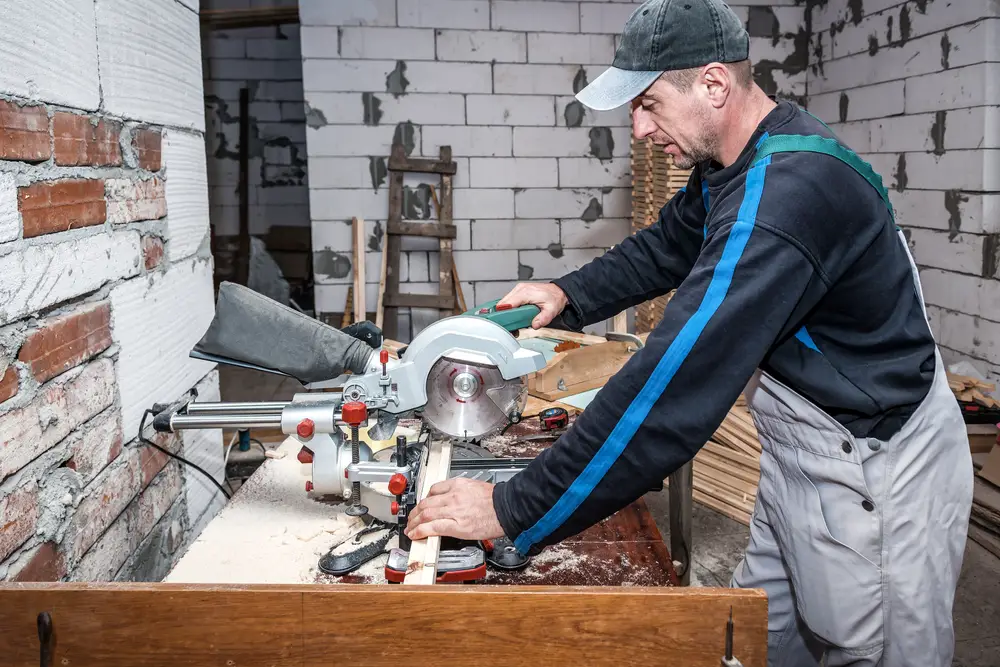
Understanding ON/OFF Controls and Safe Operation
When using a mitre saw, it is important to have a clear understanding of the ON/OFF controls and to prioritise safety throughout the operation. Different mitre saw models come with various types of ON/OFF controls. Some saws require a pre-travel motion to activate the motor, while others utilise a spring-loaded trigger/release mechanism. The latter option is considered safer as it helps prevent accidental starting of the saw, providing an additional layer of protection.
Safety Tips:
- Always familiarise yourself with the specific ON/OFF controls of your mitre saw model.
- Ensure that the workpiece is properly clamped and secured before starting the saw.
- Adjust the cutting depth and position of the workpiece to prevent the blade from contacting the turn base.
- Be mindful of your hand placement and avoid reaching too close to the blade.
- Use a push stick or other appropriate tool to guide the workpiece during cutting.
| Safe Operation Guidelines | Unsafe Operation Practices |
|---|---|
| Securely clamp the workpiece and use appropriate tools for guidance. | Using hand pressure instead of clamps to hold the workpiece. |
| Position the workpiece to prevent blade contact with the turn base. | Allowing the blade to contact the turn base during cutting. |
| Familiarise yourself with specific ON/OFF controls of your mitre saw. | Operating the saw without understanding the ON/OFF controls. |
Maintaining and Inspecting the Mitre Saw for Safety
Proper maintenance and regular inspections are crucial to ensure the safe and efficient operation of a mitre saw. By taking the time to inspect and maintain your saw, you can minimise the risk of accidents and extend the lifespan of the tool. Here are some essential maintenance tasks and inspections to keep in mind:
Blade Inspection
The blade of a mitre saw is the most critical component, and regular inspection is necessary to ensure its integrity. Check the blade for any signs of damage, such as cracks or missing teeth. A damaged blade can lead to unsafe cutting and risk of injury. If you notice any issues, promptly replace the blade with a new, suitable one.
Vibrations and Wobbling
Excessive vibrations or wobbling during operation can indicate improper installation or a problem with the blade. Inspect the saw for any loose or worn-out parts that may contribute to vibrations. Adjust or tighten any loose components as necessary. If the vibrations persist, it is recommended to consult a professional or the manufacturer for further assistance.
Cleaning and Debris Removal
Regular cleaning of the mitre saw is essential to maintain its performance and safety. Remove any wood chips, dust, or debris that may have accumulated on the saw table, blade guard, or other components. Use a soft brush or compressed air for thorough cleaning. Additionally, clean the blade using appropriate methods to remove gum and wood pitch buildup, as these can affect cutting efficiency.
| Maintenance Task | Frequency |
|---|---|
| Blade Inspection | Before each use |
| Vibrations and Wobbling | Regularly check during use |
| Cleaning and Debris Removal | After each use |
By following these maintenance tasks and inspections, you can ensure that your mitre saw operates safely and reliably. Remember to always refer to the manufacturer’s instructions for specific maintenance requirements and recommendations. Taking care of your mitre saw will not only protect you from potential accidents but also contribute to the longevity of the tool, allowing you to enjoy precise and efficient cuts for years to come.
Additional Safety Considerations for Using a Mitre Saw
When it comes to using a mitre saw, some additional safety considerations can help prevent accidents and ensure a safer working environment. These precautions go beyond the basic safety tips and focus on specific aspects that may pose a risk if not properly addressed.
Maintaining Distance from Flammable Materials
One important aspect to consider is the proximity of flammable materials to the mitre saw. The saw generates heat and sparks during operation, which can ignite flammable liquids or gases in the surrounding area. To avoid the risk of explosions or fire, it’s crucial to keep the work area clear of any flammable substances. Make sure you are working in a well-ventilated space and store flammable materials away from the saw.
Removing Nails from the Workpiece
Before cutting any wood with a mitre saw, always check for and remove any nails or other metal objects embedded in the workpiece. Cutting through nails can damage the saw blade and cause it to kick back, leading to potential injury. Inspect the wood thoroughly and use a metal detector if necessary to ensure there are no hidden nails. Taking this simple precaution can help you avoid accidents and extend the life of your saw blade.
Proper Positioning and Securing of the Workpiece
Proper positioning and securing of the workpiece is crucial for safe mitre saw operation. Always position the workpiece against the fence and use clamps or a vice to secure it in place. Avoid holding the workpiece with your hand while cutting, as this can lead to loss of control or accidental contact with the blade. By maintaining a secure and stable workpiece, you can minimise the risk of accidents and ensure accurate cuts.
Summary:
When using a mitre saw, it is important to consider additional safety measures such as maintaining distance from flammable materials, removing nails from the workpiece, and properly positioning and securing the workpiece. These precautions can help prevent accidents and create a safer working environment. By taking the time to address these considerations, you can enhance your safety and confidence when using a mitre saw.
Conclusion
Safety should always be my top priority when using a mitre saw. By following the proper safety precautions, such as wearing safety glasses, clamping the workpiece, and understanding the controls and maintenance requirements, I can minimise the risk of accidents and injuries. It’s crucial to stay informed and take the necessary steps to ensure a safer DIY journey with my mitre saw.
Using a mitre saw without accidents requires careful attention to safe usage and accident prevention. I must always be mindful of the potential dangers and take necessary precautions to protect myself and others. By securing the wood correctly with clamps and avoiding hand pressure, I can significantly reduce the risk of serious injuries.
Understanding the anatomy of a mitre saw is essential for safe operation. From the circular blade mounted on a pivoting arm to the functioning guard and fence, each component plays a crucial role in preventing accidents. It’s important to familiarise myself with how the saw works and the purpose of each part to ensure I operate it safely.
Preventing mitre saw accidents requires me to adopt essential safety tips. Wearing safety glasses is a must to protect my eyes from flying debris. I should always secure the workpiece with clamps instead of using my hand and never reach around the blade during operation. Waiting for the blade to stop before making any adjustments or moving the workpiece is also vital for accident prevention.
FAQ
Are mitre saws safe to use?
Mitre saws are generally safe to use, but accidents can still happen if proper precautions are not followed.
What are the common injuries associated with mitre saw operation?
Common injuries include eye injuries caused by flying debris and off-hand injuries where the non-operating hand accidentally comes into contact with the blade.
How can I prevent mitre saw accidents?
To prevent accidents, always wear safety glasses, secure the workpiece with clamps instead of using your hand, and ensure the saw’s guards are in place.
How should I operate the mitre saw safely?
Operate the saw with caution, making sure the workpiece is properly secured and that the blade does not contact the turn base during the lowest position.
How should I maintain and inspect my mitre saw for safety?
Regularly inspect the blade for damage, clean it properly, and check for any vibrations or wobbling that could indicate poor installation or an imbalanced blade.
Are there any additional safety considerations for using a mitre saw?
Yes, avoid using the tool near flammable materials, remove nails from the workpiece before cutting, and properly position the saw to minimise awkward operator positioning.
- Drill Battery Maintenance: Essential Tips for Cordless Drill Battery Care - February 5, 2024
- Troubleshooting Drill Issues - February 5, 2024
- Quick Drilling Techniques - February 2, 2024

